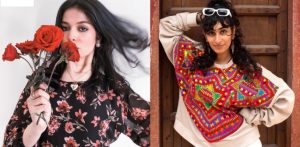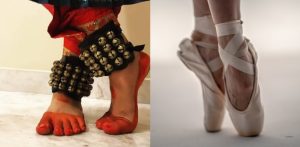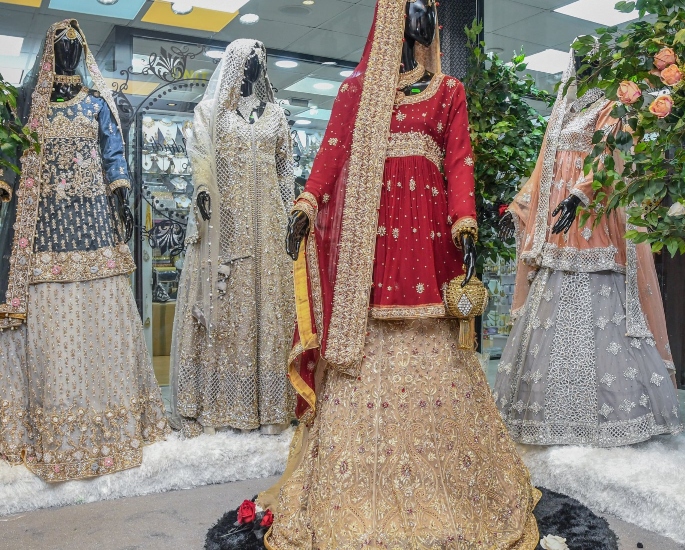Princess Diana looked effortless in traditional attire
Salwar kameez, also known as shalwar kameez, is a traditional dress commonly worn in countries such as Pakistan, India, Bangladesh and Afghanistan.
The garment frequently consists of a salwar, which is a baggy drawstring trouser and a kameez, which is a long tunic.
Although this ensemble is worn by men, the salwar kameez is often accompanied by a dupatta or chunni (shawl) for women.
Interestingly, the salwar kameez emerged out of many traditions and cultures and it holds a great deal of respect.
The suit is widely known for providing the wearer with comfortable eloquence.
The salwar kameez has been around for centuries and has a long rich history that many people may not know about.
DESIblitz discusses the origins of this much-loved garment, its history and how it has evolved over the years.
Origins
When a person thinks of the salwar kameez, they would inevitably think it originated from Pakistan and India, however, this is not the case.
The history of the outfit is not just isolated in one country.
Although the exact date and origins are unknown, the Mughal Empire (1526-1857) is believed to have been the first colony of people to introduce the outfit to the world.
However, through evolution, the modern-day salwar kameez has traces of Persian influence.
The word salwar is a Persian word that means “a form of baggy trousers” with a drawstring. While kameez is an Arabic word meaning long tunic.
In October 2016, Monisha Kumar and Amita Walia published a research paper titled ‘Elucidation of the Indian Salwar Kameez’. Within the publication, they suggest that:
“It can be easily interpreted that the origin of the garment, salwar kameez, is either Persian or Arabic.”
Basic Arab dress for both men and women consisted of a “simple tunic and an unfitted garment pulled on over the head”.
In addition, countries like Turkey were heavily impactful on South Asia, notably influencing the salwar kameez.
The classical Turkish dress consisted of loose-fitting salwar’s, with a shirt and a long jacket called the ‘?alvar’.
The Muslim Seljuk Turks “emerged from Central Asia, establishing dynasties in Iran and Asia by the eleventh century”. They spread Islam and Turkic culture.
The Selijuk Empire “later morphed into the Ottoman Empire”. The Ottoman Empire encompassed “most of the lands surrounding the East Mediterranean” by the mid-sixteenth century.
Kumar and Walia maintain:
“The 500-year Ottoman rule throughout the Arab world resulted in the blending of garment forms.”
Further expressing:
“The adoption of buttoned vests or jackets of silk or wool decorated with embroidery, and the loose-fitting trousers salwars are evidence of such borrowings in Arab dress.”
They also mentioned how the traditional dress of Iran and Afghanistan of layered coats and salwars also lends support to the blending of garment forms.
These forms of the salwar and the kameez was in fact introduced in South Asia when the Muslims conquered India in the 12th century.
Author Ming-Ju Sun in the book Traditional Fashions from India Paper Dolls (2001), stated:
“Much of traditional Indian women’s clothing changed in the 12th century when Muslims conquered north and central India.”
Prior to this, the clothing of the Indian subcontinent consisted of various draped garments.
In her book Clothing Matters: Dress and Identity in India (1996), Emma Tarlo asserts that this was due to:
“The comparatively limited range of stitched clothes available in pre-medieval India was, however, greatly expanded during the Sultanate and Mughul periods when various types of trousers, robes and tunics gained in popularity.”
Ming-Ju Stun expressed:
“New dress styles were developed to cover the body as much as possible, befitting Islamic preferences.”
Muslim women mainly wore a dupatta veil, with a long tunic kameez and a trouser style salwar.
Following the invasion of the Muslims, gradually many Hindu women in the subcontinent adopted the dress.
It was mainly worn in the Punjabi northern areas of the subcontinent and it was in this area where it cemented its place as the regional style of Punjab.
It has been worn in that area for centuries and after some transitions, the dress is popularly known as the salwar kameez.
Types of Salwar Kameez
After the salwar kameez became popular amongst both men and women in the Indian subcontinent, most specifically in the northern areas, many variations have developed.
Although the foundations of the outfit remain the same, it is the way these styles are all cut differently that makes them unique.
Patiala Suit
The Patiala salwar kameez consists of a very baggy salwar that is stitched in pleats and worn with a knee-length kameez.
It requires double the length of material, due to the pleats however, the fall of the pleats gives a gorgeous cowl effect at the back.
The Patiala salwar kameez has its roots in Patiala City, a northern region state in Punjab, India.
From 1813-1845, this specific style was in fact developed as a majestic dress, as it was the royal dress of the King of Patiala, Maharaja Karam Singh.
In order to make it more regal, it was originally made in rich materials accompanied by diamond necklaces as the salwar was mainly worn by men during this period.
However, over the years with the emergence of new cuts and styles, it has evolved into a woman’s salwar kameez style.
Due to the looseness and lightweight fabrics, it is very comfortable to wear and preferred by women in Punjab because of the hot climate.
Churidar
The churidar style of this cultural outfit is “the redefined form of the traditional” salwar kameez.
The salwar is extremely fitted and narrow and wrinkles at the wearer’s ankles, exposing the shape of your legs. The churidar is worn with a dress like a kameez accompanied by a dupatta.
The churidar looks very much like western leggings, but it is actually much longer than your leg therefore it stacks at the ankle.
The excess fabric almost gathers at the ankle like bangles on the wrist, this is in fact where the name comes from.
Churi means ‘bangle’, while dar means ‘like’ – so essentially it means a salwar that is ‘like a bangle’.
This style is worn widely across both Pakistan and India and gives off an extremely stylish elegant look whilst complimenting different body types.
Anarkali
Anarkali suits consist of a long frock style kameez with a churidar or salwar trousers. The kameez is normally flared at the bottom, imitating western formal dresses.
However, this wide cut gleams with its beautiful embroidery and contrasting stitching making the ensemble pop.
This type is named after Anarkali, a court dancer from Lahore, Pakistan. Anarkali was thought to be the love interest of Mughal Emperor Jahangir.
The salwar kameez gives off an effortless feminine vibe and looks gorgeous on anyone who wears it.
In Urdu, anarkali means ‘delicate bud of the pomegranate flower/ tree’.
This name is thought to signify innocence, softness, and beauty. Subsequently, the women that wear it are thought to possess the same qualities.
It is a timeless style that has evolved greatly over the years and there are in fact different types of anarkali suits available.
These include churidar anarkali suit, cape style anarkali suit, jacket style anarkali suit, layered anarkali suit, floor-length anarkali suit, gown Style anarkali suit, and palazzo anarkali suit.
Printed Suits
In recent years, printed salwar kameez suits have become popular.
They are called printed salwar kameez’s as they have been either machine printed or digitally printed.
A variety of designs can be printed and fabrics such as georgette, crepe, cotton, and chiffon. The printed designs tend to give off a more casual look.
Although, more modern styles that incorporate floral and cultural designs have made printed suits a go-to outfit for many occasions whether it’s a family gathering or engagement party.
Sharara
The Sharara is another variation of the salwar kameez. It consists of a straight kameez, with a flared wide-legged trousers that almost resembles a lehenga.
Embellished with gorgeous and vibrant sequins, stones and beads, the sharara has been popular in India since the early 60s, due to Bollywood movies.
It was in the 90s and early 2000s that transcended this certain style again. Even more recently, Deepika Padukone shone in the 2015 film, Bajirao Mastani, with her incredible and elegant sharara suits.
The style is popular amongst young South Asian women, especially given the modern and sleek designs that are taking over the fashion world.
Gharara
Another variation to the classic salwar kameez is the gharara style.
The gharara consists of a short kameez with a trouser that is fitted from the waist to the knee and then flares out just above the knee to the toes.
It originated in the Awadh region of Uttar Pradesh, India, during the 18th century.
The gharara is a traditional outfit of Lucknow, the capital of Uttar Pradesh.
While it originates in India, the gharara is also extremely popular in both Pakistan and Bangladesh.
It became widely popular in the 50s when public figures like first lady Rana Liaquat Ali Khan and politician Fatima Jinnah wore them.
Balochi
The clothing of Baluchistan in Pakistan includes a variation of the traditional salwar kameez for both men and women.
For men, the salwar is very baggy and the kameez is loose with long sleeves.
On the other hand, the salwar kameez’s for women in Baluchistan are very distinct. They consist of a long loose dress kameez, with a dupatta and salwar.
The kameez’s from this region can have over 118 different compositions, using the famous silk-thread chain-stitch embroidery which results in unique balochi designs.
Peshawari Suit
Peshwar, the capital of the Pakistani province of Khyber Pakhtunkhwa, has its own style of salwar kameez.
The traditional dress includes the Peshawari salwar, which is very loose, and a khalqa (gown) that opens at the front.
The salwar kameez is not just an epitome of South Asian tradition and culture. It is also an embodiment of the diverseness of different regions in the Indian subcontinent.
The types of salwar kameez suits discussed are worn in different regions, communities and cultures.
However, over the years the styles have greatly evolved and the designs have become popular all over South Asia, not just in a specific region.
Pakistan
The salwar kameez is well-loved in Pakistan. In 1973, it became the national dress of Pakistan and is worn avidly by both men and women.
In Pakistan, the salwar kameez is worn in many exquisite colours and designs.
Each province has its own version and style of this national dress, including the Sindhi, Punjabi, Balochi, Kashmiri, and Pashtun cuts.
Since 1982, government officials working in the Secretariat in Islamabad are required to wear a salwar kameez.
Over the years it has also emerged as a political statement. This was particularly done by former Pakistan President, General Zia-ul-Haq Bhutto, who wore it during his public rallies.
Much more than an epitome of tradition, it is also an exemplar of nationalism in Pakistan.
Since ex-cricketer, Imran Khan became Prime Minister of Pakistan he has been seen wearing a salwar kameez.
The Print publication expressed:
“The man who once wooed the world in blue jeans, dapper tucks and sunglasses has now religiously taken to the simple white ‘shalwar-kameez’.”
He is always seen in traditional attire, even when he goes abroad for visits. Most famously he wore a navy-blue salwar kameez on his visit to the White House in 2019.
India
Although the national dress of India is the saree, the salwar kameez has become a staple in Indian fashion.
Especially in Punjab, which neighbours Pakistan in the North of India. Most Punjabi women are seen to wear this attire as opposed to the saree, which is worn more evidently in the mid to south of India.
This attire was also transported to Britain when families of migrant Punjabi men came to England in the 50s and 60s.
The salwar kameez has gradually become popular among many women in India as well as the north, especially due film and television promoting the attire.
In particular, the popularity of Bollywood fashion has heightened the prevalence of the salwar kameez.
Through time, smash-hit movies like Dil Toh Pagal Hai (1997), Veer Zaara (2004), Jab We Met (2007) have all popularised the salwar kameez.
Promoting the traditional outfit in fluorescent colours, graceful designs and luxurious cuts leaves audiences craving to look like the Bollywood starlets.
Moreover, unlike the sari, which requires practice and poise, the salwar kameez is much more practical for modern-day life.
This is one of the major reasons why women in India opt for this co-ord, especially as it is more comfortable in the Indian heat.
The salwar kameez is particularly popular amongst younger Indian women.
In the 1980s, Indian government schools adopted the dress as their official uniform for school girls aged 12-16.
Due to this, the salwar kameez is also popular amongst college and university students in India. Often the traditional kameez’s are worn with jeans for more of a modern fusion look.
Bollywood Influence
Monisha Kumar and Amita Walia state:
“Over the decades the salwar kameez has been the focus of many designers and has been transformed as per the prevalent fashion trends.”
There are specific regional styles of the salwar kameez that are worn by individuals from the area.
However, predominantly the fashion worn in Bollywood films has shaped fashion trends in South Asia and have had a major influence on the evolution of the salwar kameez.
Many designers have tried to imitate the designs they see in popular films in order to meet the demands of consumers.
The 1960s – 1970s
When it came to this era of Bollywood fashion, vibrant colours and western tailoring techniques dominated the screens.
One of the most memorable styles of this period was made popular by the legendary Madhubala, who played Anarkali in Mughal-e-Azam (1960).
In one of the scenes, she wore a colourful embroidered Anarkali suit and it quickly became an iconic Bollywood look.
The popularity of this film helped to bolster the Anarkali suit more widely as the vibrancy attracted many designers.
Also, during this period Bollywood played a major role in endorsing the churidar kameez.
The style became very fashionable in the 60s and costume designers like Bhanu Athaiya transcended the look.
Notably, actress Sadhana Shivdasani in the film Waqt (1965) wore a white sleeveless figure-hugging kameez, with a churidar and a diaphanous dupatta.
This was a ground-breaking style that reflected the confidence of the liberated woman who was breaking traditional conformity.
It became a classic look of the swinging 60s and developed into a must-have in every fashionista’s wardrobe.
The 1980s
This era saw a continuation of the Anarkali suits in Umrao Jaan (1981), which was inspired by the 1960 movie Mughal-e-Azam.
Rekha wore an iconic metallic gold Anarkali, net dupatta, and the classic 80s gold jewellery and glossy red lips.
Along with this, plain or sometimes sequined fitted salwar kameez suits became popular. They were sometimes paired with waistcoats for a more experimental look.
This can be seen in Zeenat Aman’s classic sequin pink salwar kameez in the 1980 film Dostana.
Long-sleeved flared kurta with a pajama salwar also was seen quite frequently in 80s Bollywood movies.
The 1990s
The 90s witnessed changes in the economy and a fresh new bolder generation which was reflected in Bollywood films and their fashion.
This decade turned towards more sheer and strappy salwar kameez’s with a skinny dupatta that was sometimes worn around the arms.
The kameez’s often showed more chest with the deep V necks illustrating the cultural shift towards more revealing ensembles.
The minimalistic look was seen most famously on Madhuri Dixit in Dil Toh Pagal Hai (1997).
The suits she wore were often made out of chiffon and were monochromatic, in colours such as white and yellow. This look became an instant hit within the fashion world.
The 2000s
In the 2000s, Bollywood fashion had more of a free-spirited colourful vibe. Short kurtas paired with loose Patiala salwars were frequently seen on screen.
The film Bunty Aur Babli (2005) featured a new trendy look of a collard short kurta and colourful Patiala sported by Rani Mukherjee.
Rani became an icon amongst college-goers with her easy, comfortable, and stylish wardrobe.
Similarly, Kareena Kapoor’s outfits in Jab We Met (2007) were well-loved by millennials.
She wore both plain and colourful kurta with the Patiala salwar. In the film, she also wore more of a fusion look when she paired the patiala salwar with a T-shirt and no dupatta.
The 2000s also saw the release of the popular film Kabhi Khushi Kabhie Gham (2001).
As previously mentioned, the film showcased some amazing saris and salwar kameez’s worn by Kajol, but also popularised some different styles of salwar kameez’s.
In the song ‘Bole Chudiyan’, Kareena Kapoor wore a creation by designer Manish Malhotra creation. She wore a pink embroidered cropped kameez with a boot-cut sharara style salwar.
This is an absolute iconic salwar kameez look that is easily the most famous ensemble from the film.
Check the famous outfit out:

2010 onwards
Aside from the fancier salwar kameez’s adored on-screen, the fashion of newer Bollywood movies tends to be more modern and functional.
The fashion includes short kameez’s with loose salwar’s or palazzo style salwar.
A prime example of this was Deepika Padukone’s outfits in the 2015 film Piku. Deepika, who played Piku, dressed in a modern kurta with ankle-length palazzos.
At another point in the film, she dons a monochrome paneled kameez with a breezy palazzo salwar.
The look was completed with traditional jutti (traditional shoe), a bindi, and oversized sunglasses, which created a perfect modern Desi look.
The outfits within the film have frequently been praised as getting everyday modern Indian fashion right.
These looks in the film combined style and functionality. They clearly show how the salwar kameez has evolved into the perfect attire for the modern Desi woman.
Transcending Barriers
Longstanding Fashion
In western society, clothing goes in and out of fashion very quickly, especially due to the rise of fast fashion. Every year there is a new hot trend that people run to replicate.
In the 90s the grunge look with flannel shirts, ripped jeans and Doc Martens or the more streetwear look of oversized sportswear and chunky trainers were popular.
Whereas by the time the 2000s came around this switched to low-rise jeans, stocky belts, Juicy Couture tracksuits and mini baguette bags
Marketing manager, Khadija Rahman, at Pakistani clothing brand, Generation, spoke to The Express Tribune, revealing:
“In most countries, traditional garb died because it failed to evolve.”
Going on to assert:
“This has not been true with the shalwar kameez.
“The shalwar kameez has seen itself adapt to local and international trends in an original fashion…”
Unlike western fashion, the salwar kameez has stood the test of time and has evolved in every era.
The designs are just variations of the traditional salwar kameez. Despite the modifications, the salwar kameez has been worn for centuries and will continue to be worn.
Whilst western trends such as vintage clothing, baggy jeans and oversized shirts tend to fluctuate yearly, the salwar kameez remains a staple amongst South Asian countries.
This is what makes it a truly unique symbol of Desi tradition and culture.
Salwar Kameez for Everyone
Kumar and Walia express:
“The costume, once worn only by the Muslim women across the subcontinent, is now popular among the women of all faiths and ages.”
Within western society, there are rarely any items of clothing that are worn by both genders of different classes and ages.
There tend to be big differences in what older and younger generations wear or what is considered appropriate for different ages. However, this is not the same case with the salwar kameez.
The salwar kameez transcends social class, gender differences, cultural differences and generational gaps.
This can be clearly witnessed in the marketing campaigns for the Pakistani brand, Generation.
Founded in 1983 by husband-wife duo, Saad and Nosheen Rahman, Generation is an affordable fashion brand for every Pakistani woman.
Their brand ethos is representing all types of women in an innovative and creative manner. Speaking about their brand they express:
“The Generation story begins from a family and moves forward with the concept of building upon this family, whether it is customers, workers, students or so on.
“Each type of line is a further personification of her various faces, they represent her in different timeframes and moods. Festive, casual, young, demure.”
Their marketing campaigns have always aimed to be inclusive and represent all, rather than a minority of Pakistani women.
They have made a consistent effort to represent a range of real women in their advertisements.
Generation showcases their designs on a range of skin tones, body types, ages and gender identities. This can be seen in their 2017 campaign.
In October 2017, Generation showcased their ‘Greater than Fear’ autumn/winter collection. The campaign included 20 women aged between 20 to 72, wearing their salwar kameez’s and kurtas.
The campaign included 54-year-old Anjum Naveed. When asked about what she feared most, she replied:
“At this age, I worry that I will become stagnant, I was dreading the irrelevance that old age can bring with it.”
This comment sparked Generation’s next wedding collection campaign – ‘Shehnaz ki Shadi’.
The campaign stars Anjum as a bride, who is marrying for the second time, surrounded by her daughters and friends.
The aim of the campaign was to empower older Pakistani women to marry and be happy without being judged. The ad includes a range of women in different fancy salwar kameez’s.
The salwar kameez’s presented ooze a combination of tradition and modernity, with their pops of colour, classic silhouettes, delicate embroideries and rich velvets.
The Generation ad highlights how the salwar kameez is for everyone of all ages.
With slight modifications to the fabric, style and colour the salwar kameez is suitable for everyone at any time and any place.
Be it working in the home or in an office or attending a wedding, the salwar kameez is a garment for everyone.
Salwar Kameez in Global Media
The salwar kameez is a staple clothing item in countries like Pakistan, India, Bangladesh and Afghanistan. The suit is also worn avidly by the South Asian diaspora across the globe.
While it is worn religiously by many people, the popularity and acknowledgement of the suit often stay within this community.
However, the salwar kameez has made international headlines at certain points in time, most famously by Princess Diana and the Duchess of Cambridge, Kate Middleton.
Princess Diana
The late Princess Diana, known as ‘the people’s princess’, had a strong connection with Pakistan and visited multiple times.
She was great friends with now Prime Minister of Pakistan, Imran Khan and his first wife Jemima Khan.
Princess Diana visited Pakistan 3 times in 1991, in 1996, and in 1997 and is often remembered for her iconic style. On some occasions, while in Pakistan, she wore the traditional salwar kameez.
Princess Diana looked effortless in traditional attire and the outfits have been coined as some of her iconic looks. While in Pakistan, her ensembles made headlines at the time and still continues to do so.
Most famously on a visit to Lahore, with Imran and Jamima Khan, she wore a stunning blue salwar kameez by designer Ritu Kumar.
Diana’s love for the salwar kameez was highlighted by Ritu Kumar, who took to Instagram in April 2021 to confess:
“Diana was a patron of my store in London. She would call the store herself when she wanted to visit.
“She would only request us to keep a part of the store free of customers to give her some privacy, and would enjoy browsing there.”
Diana was also seen wearing a dazzling turquoise kameez with a trouser salwar, as well as a dark blue and embroidered salwar kameez.
However, it was not just in Pakistan that Diana wore the traditional salwar kameez. In 1996, a cancer charity event was held in London’s Dorchester Hotel by Imran Khan.
She wore an elegant peal and gold-encrusted salwar kameez, which was a gift from Khan’s wife, Jemima.
The princess’s salwar kameez looks were brought back into the limelight again following the Duke and Duchess of Cambridge’s visit to Pakistan.
Duchess of Cambridge
In October 2019, the Duke and Duchess of Cambridge undertook their first official visit to Pakistan, at the request of The Foreign and Commonwealth Office.
While on the trip, similar to her late mother-in-law, Kate Middleton wore traditional Pakistani attire.
On the tour, she wore a casual blue salwar kameez which had delicate embroidery on the neckline and looked graceful.
When visiting Badshahi Mosque, in Lahore, she wore an elegant green and gold trouser style salwar kameez.
This piece was made from French chiffon and was hand-embroidered with gold silk by the tribespeople of Swarth.
These two suits were created by a local Pakistani designer, Maheen Khan.
Even the accessories Kate wore paid tribute to local Pakistani businesses. The earrings are worn with her blue suit in fact come from the affordable Pakistani fashion brand, Zeen.
Everything the Duchess wears makes headlines and this time was no different.
The salwar kameez’s she wore was heavily praised by the media. Like People magazine who declared it as “another day, another stunning shalwar kameez for Kate Middleton!”
On another day, when the Duchess was seen playing cricket, she was wearing a gorgeous white salwar kameez by local brand Gul Ahmed.
The suit compromised of a trouser salwar and kameez that was embroidered with stunning white flowers.
She accessorised the look with nude J. Crew heels, a Mulberry wallet clutch and minimal jewellery.
Publications all around the world adored Kate’s outfits on the tour and often drew resemblance to some of the salwar kameez’s Diana wore.
Usually, the salwar kameez is only loved amongst the South Asian community, however, Kate’s honour to traditional Pakistani fashion is great to see.
Sarah Shaffi, Digital Editor of Stylist reiterated this:
“As someone who grew up wearing shalwar kameez – and as someone who still wears it on an almost daily basis – seeing Kate embrace the clothing of Pakistanis has been wonderful.
“She’s shown respect for Pakistani people, supported local designers, and put her own sartorial spin on her outfits, marrying style and substance in the best way possible.”
The British royal family wearing the salwar kameez has meant it is not just an item adored by people of the culture.
The traditional garment has been brought into the eyes of the world as an elegant attire that has centuries of tradition attached to it.
Cultural Appropriation
In recent years, some global brands have been slated for appropriating the salwar kameez.
In 2019, British online clothing company, Thrifted, suffered backlash for cultural appropriation.
They sold a South Asian kameez for £29.99, yet marketed it as a “vintage Boho dress”. The models wore the kameez as a dress with no trousers.
The brand received a lot of backlash on social media for its careless cultural appropriation. An ASOS user commented about the double standards, saying:
“When we wear it, it’s unacceptable. When they wear it, it’s fashion?”
While another shopper stated:
“Vintage Boho dress????? Girl you got a damn kameez with no salwar.”
Due to the backlash, Thrifted removed the items from the website and issued an apology, claiming they did not know that these were salwar kameez suits:
“Thrifted.com purchased a bulk mix of vintage/second-hand dresses from a supplier who had labelled them as ‘boho’.
“They were then listed on the website under this name. It was brought to the customer service team’s attention that not all of these second-hand dresses were actually boho dresses.”
Further asserting:
“All of these items were then removed from our website. We apologise for any offence caused.”
In March 2021, Spanish clothing retailer Zara was selling an “oversized shirt” with matching bottoms for £89.99.
Many customers took to Twitter to announce its resemblance to a salwar kameez:
Not Zara trying to sell me a 'limited edition' cotton shalwar kameez for £90 when I could buy the material for £20 from White Abbey Road & my mum could it sew for free ????? pic.twitter.com/iPqH6vaCzU
— Sabbiyah Pervez (@SabbiyahPervez) March 18, 2021
Journalist Nabeela Zahir reiterated the double standards of these brands:
“Shalwaar kameez trendy unless on a (south) Asian?”
The salwar kameez has changed drastically over the years, however has always kept a close relationship with tradition and culture.
Western brands have frequently “reinvented” the salwar kameez without acknowledging the centuries of tradition and culture behind them.
They have unfortunately marketed it as something else and that too at a ridiculously high price.
Salwar Kameez in the West
In Britain, the South Asian diaspora adore the salwar kameez. There are many areas in Britain that sell a range of different types of salwar kameez’s for everyone’s taste.
Places like Southall and Stratford Road in London, Wilmslow Road in Manchester and Soho Road in Birmingham have been selling the traditional garment for decades.
Also, some amazing online South Asian clothes shops have appeared in recent years.
The salwar kameez has physically cemented its place in Britain, but how do the wearers feel when wearing it in the West?
British Pakistani, Saima*, expressed:
“When I was younger, I used to get really embarrassed wearing salwar kameez out to the shops or to restaurants.
“But, as I got older I realised it’s nothing to be embarrassed about and it’s my way of repping my Desi culture. I wear it out all the time now.”
Wearing your cultural clothing in western society is nothing to be ashamed of. However, unfortunately occasionally, for some, it can present a barrier.
63-year-old Arfana* mentioned how she always wears a salwar kameez, as it is what she feels most comfortable in.
She recalled a time when she was at a hospital appointment wearing a salwar kameez:
“The nurse thought I could not understand or speak English, she was addressing the questions at my daughter and asked her to come in the room with me to help me answer the questions.”
Going on to state:
“I assume this was because I was wearing a salwar kameez and not western clothing.”
There are prejudices linked to clothes and unfortunately, experienced quite frequently. Especially by older South Asian women who opt to wear their traditional clothes on a daily basis.
Importance of the Salwar Kameez
The evolution of the salwar kameez, over the years, has meant it has held a special place in the wearer’s heart, throughout their life.
It is a traditional outfit that upholds tradition and culture and for many, this is the reason they wear it.
Kiran* from England revealed:
“I feel clothing is one of the major ways I feel connected to Desi culture, especially living in Britain I do not get to wear a salwar kameez every day, but when I do it is really special.
“I have many memories of my mum buying me fancy salwar kameez’s when I was a child and I love doing the same with my children.”
Whilst 36-year-old Sumaira expressed:
“I am Pakistani, that’s what we wear. Just like I grew up eating Desi food, I have grown up wearing it, it’s part of my culture.”
For many, the salwar kameez holds an important place in their life as a synonym of Pakistani culture and tradition.
Due to this, many feel they need to uphold this when visiting Pakistan.
22-year-old Zahra told DESIblitz:
“When I go to Pakistan, I wear a mix of Pakistani kurtas and salwar kameez, because I feel it’s more culturally appropriate.”
This sentiment was also felt by 30-year-old Aisha* who said:
“Whenever I go to Pakistan, I hardly pack western clothes, I feel a bit weird wearing them in Pakistan. I tend to only wear salwar kameez.”
Apart from being a traditional outfit, the salwar kameez holds an important place for its elegance, ease and comfort.
Zahra said:
“I think the salwar kameez is more flattering generally and also has a better variety of colours and patterns, compared to western wear.
“I find the salwar kameez is more modest than most western wear.”
Salwar kameez is an extremely gracious clothing item that covers the wearer’s body, providing a modest fashionable look.
Even after all these years and the rise of western fashion, the salwar kameez is still adored by its wearers. On one side it is an epitome of tradition and on the other an epitome of ease and comfort.
An Evolving Garment
Sumaira explained to DESIblitz:
“I think salwar kameez fashions change every year.
“I think nowadays you can get away with more diverse shapes and styles, whereas in the past it always was about what was on trend and everyone would be wearing that style.”
The salwar kameez has been around for centuries, yet has never failed to please.
It has evolved over the years and has always managed to stay contemporary by incorporating different cuts and trends.
The evolution of salwar kameez is seen the most through the changes in styles in Bollywood films.
Bollywood films have allowed the styles to become more widely popular and not just in the region they originated from.
It is a clothing item that is worn by men, women, boys, and girls alike and holds a special place in the lives of many South Asians.
In addition, the widespread attention from British brands and the royal family has skyrocketed the salwar kameez into mainstream fashion.
The salwar kameez has changed so much as each decade passes, it would be interesting to see how it further evolves in the decades to come.













































































